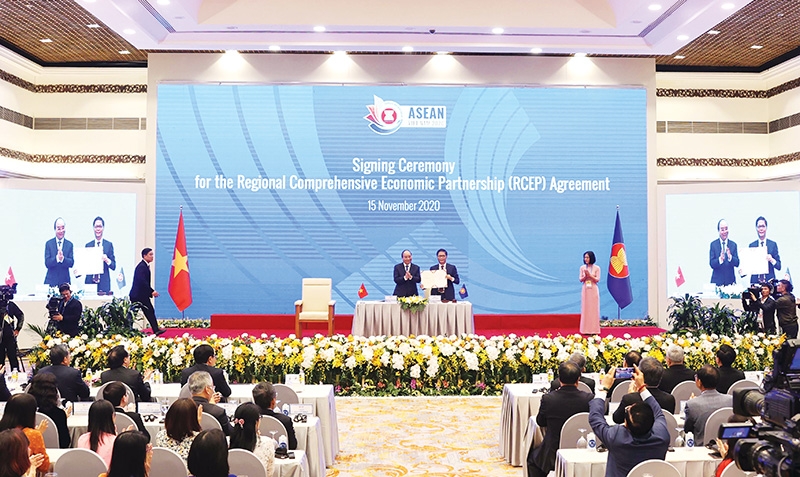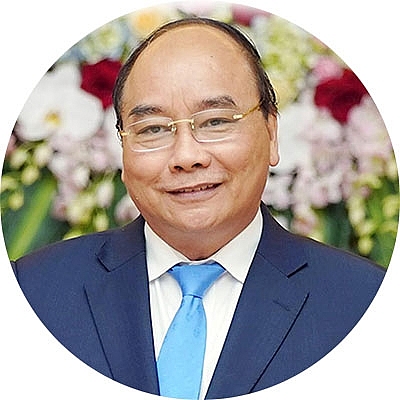A year of adjustment for Vietnam’s ASEAN plans
 |
| The signing ceremony of the RCEP marks the beginning of one of the largest free trade agreements in the world |
The unexpected COVID-19 pandemic has done much to upset Vietnam’s 2018 and 2019 preparations for taking ASEAN’s chairmanship role this year. While all member states focused resources on protecting their people, the question was whether or not nations would, or could, continue with the commitments to pursue the long-term goals of developing the ASEAN Community.
“Vietnam has to find ways to adapt and has switched plans to properly meet what ASEAN countries need. So we have turned our priorities to fighting COVID-19,” said Nguyen Quoc Dung, Deputy Minister of Foreign Affairs. “Moreover, we also didn’t want to abandon all of the works that regional countries have built and to interrupt community-building efforts, so we have continued to come up with initiatives to maintain the process of building the ASEAN Community.”
“The workload has become 2-3 times heavier than before but fortunately, we have made efforts since early this year to accomplish the responsibilities,” he added.
Never has ASEAN witnessed the signing of a record number of cooperation agreements laying firm groundwork for the bloc to develop in the new decade – as at the recent 37th ASEAN Summit and related summits – with one of the focuses laid on economic connectivity in which further cementing trade and investment cooperation counts most.
At the event last month, over 80 documents were adopted to cement the joint efforts of ASEAN member states and their partners in strengthening cooperation against the backdrop of the pandemic. “The number of approved documents was the largest in the history of all ASEAN meetings,” stated Vietnamese Prime Minister Nguyen Xuan Phuc.
Trade significance
All initiatives proposed by Vietnam as ASEAN chair for the year were discussed, approved, and welcomed by the bloc’s leaders and partners. Initiatives on establishing an ASEAN COVID-19 Response Fund, ASEAN Regional Reserve of Medical Supplies, and ASEAN Regional Centre on Public Health Emergencies and Emerging Diseases received donations from many countries. The bloc has also established the ASEAN Smart Logistics Network with its first project, the Vinh Phuc ICD Logistics Centre.
This project, located in the northern province of Vinh Phuc, was approved by the provincial People’s Committee which is now seeking investors. With an estimated total investment of $166.3 million, it is designed for a combined cargo capacity of 530,000 twenty-foot equivalent units. The centre will act as a distribution hub as well as an inland clearance depot in a bid to provide logistics services and meet market demand.
“Notably, the signing of the Regional Comprehensive Economic Partnership (RCEP) holds a significant meaning to not only ASEAN but also global trade, helping minimise impacts caused by global supply chain disruption,” PM Phuc stated.
“After the signing, RCEP member countries will follow their internal process to ratify the deal,” he said. “This will help drive ASEAN’s economic, trade, and investment ties forwards and make it more convenient in materialising the bloc’s vision to build a more prosperous ASEAN by 2025.”
On November 15, the 10 ASEAN member states were among the 15 Asia-Pacific nations that signed the RCEP. Together with China, Japan, South Korea, Australia, and New Zealand, the RCEP marks the world’s largest free trade agreement (FTA) by population and GDP, as well as the first time China, Japan, and South Korea have entered into an FTA together.
The RCEP seeks to eliminate 90 per cent of import tariffs between member states within 20 years of it coming into effect, as well as promote the flow of services and investment while setting out regulations around rules of origin and intellectual property.
“As such, ASEAN countries are expected to benefit from an easing of trading restrictions with the five other RCEP members, potentially bolstering goods exports and increasing the supply of high-quality products into their respective domestic markets,” global data analyst and provider FocusEconomics told VIR last week in a statement. “Furthermore, the signing of such a significant trade deal – coming at a time when protectionist policies are creeping into fashion among many major international economies – could boost business sentiment and broaden appetite for ASEAN investments and services.”
Ma Tieying, economist at Singapore-based DBS Bank, commented that the RCEP would help to further promote Japan, China, and South Korea’s foreign direct investment in ASEAN. The three respectively ranked as the first, third, and fourth-largest foreign investors in ASEAN in the 2015-2019 period on a single country basis.
Chinese firms have been actively investing in ASEAN in recent years, in the context of trade tensions with the US, as well as China’s push for the Belt and Road Initiative and Digital Silk Road. Japanese businesses have also been looking for more investment opportunities in ASEAN, as part of their long-term strategy of supply chain diversification.
“The investment chapter under the RCEP is an upgrade and enhancement of the existing provisions under the ASEAN+1 FTAs. Therefore, it would help to further facilitate investment flows between ASEAN and North Asian countries in the coming years,” Tieying said.
“We noted the progress made in efforts to integrate the ASEAN region into the global economy, which include the implementation of the ASEAN’s Free Trade Area (FTA) and comprehensive economic partnership agreements with major trading partners including China, India, Japan, South Korea, Australia, New Zealand, and Hong Kong, as well as engagement with potential new partners. Recognising the important contribution of these FTAs to ASEAN’s comprehensive recovery efforts and in creating stronger and more resilient supply chains, we reiterated our call on officials to redouble efforts in ensuring that they incorporate mechanisms for the smooth flow of supply chains and continue to deliver new opportunities for businesses in the region. We announced the completion of the substantial negotiations on the Regional Comprehensive Economic Partnership and welcomed its signing, which demonstrated our strong commitment to supporting economic recovery and inclusive development as well as our support for an open, inclusive, rules-based trade and investment arrangement. We acknowledge that this agreement is critical for our region’s response to the pandemic and will play an important role in building the region’s resilience through an inclusive and sustainable post-pandemic economic recovery process.” Excerpt from ASEAN chair statement at the 37th ASEAN Summit: Cohesive and Responsive organised during November 12-15 |
Key beneficiaries
According to experts, investment from South Korea, Japan, and Singapore, which are now the three largest foreign investors in Vietnam, will maintain these places next year at the very least.
Statistics from Vietnam’s Ministry of Planning and Investment showed that as of November 20, registered investment capital from South Korea, Japan, and Singapore into Vietnam totalled $70.5 billion, $60.1 billion, and $56.3 billion, respectively.
According to analysis by the Peterson Institute for International Economics, Indonesia, Malaysia, Thailand, and Vietnam stand to benefit the most from the trade pact, which will add $2-4 billion each year to their respective economies by 2030.
“Meanwhile, panelists that we surveyed see Vietnam as the ASEAN country set to benefit most from the RCEP, likely due to its highly competitive export sector that will benefit from being plugged even more tightly into regional value chains,” the FocusEconomics statement said.
It cited Somprawin Manprasert, chief economist at Bank of Ayudhya – the fifth-largest bank in Thailand in terms of assets, loans, and deposits – as saying, “Vietnam would benefit from integration under a number of effective FTAs, including the RCEP, the EU-Vietnam FTA, and the Comprehensive and Progressive Agreement for Trans-Pacific Partnership.”
The harmonisation of tariffs and rules of origin and simplifying of customs obligations under the RCEP present the principal benefit to ASEAN economies. As a result, manufacturing is set to gain from a relocation of labour-intensive industries to ASEAN countries, particularly those with competitive employment costs such as Vietnam.
In a survey of 14 global institutions that FocusEeconomics conducted on December 4-8, most respondents commented that manufacturing would be the industry that would benefit the most from the RCEP. Within manufacturing, electronics was the sector most often mentioned as likely to gain.
ASEAN is now Vietnam’s fourth-largest export market, after the US, the EU, and China. Vietnam’s export turnover to the region surged to $24.7 billion in 2018 and $25.3 billion last year, up 1.9 per cent on-year. However, in the first 11 months of 2020, the figure hit $20.9 billion, down 10.6 per cent on-year.
Meanwhile, Southeast Asia is also Vietnam’s third-largest import market. The country’s import turnover from other member states totalled $32 billion in 2018 and $32.1 billion last year. Due to the pandemic, the figure touched $27.3 billion in the first 11 months of 2020, down 6.9 per cent on-year.
What the stars mean:
★ Poor ★ ★ Promising ★★★ Good ★★★★ Very good ★★★★★ Exceptional
Themes: Drive ASEAN Forward
Related Contents
Latest News
More News
- 72 nations sign landmark Hanoi cybercrime convention (October 26, 2025 | 18:00)
- UN Secretary-General commends Vietnam’s global leadership (October 26, 2025 | 09:00)
- APEC finance ministers convene to tackle regional challenges (October 22, 2025 | 17:31)
- Rewiring global trade: ASEAN’s rise as supply chain hub (October 17, 2025 | 11:40)
- Vietnam attends first World Nuclear Week Forum in Russia (September 26, 2025 | 10:50)
- Vietnam attends 69th session of IAEA General Conference (September 16, 2025 | 10:00)
- ADB, WB pledge over 12 billion USD for ASEAN power grid, renewable energy projects (August 15, 2025 | 14:18)
- Lowy Institute proposes AI-based tobacco control solutions for ASEAN (August 15, 2025 | 14:14)
- Cloud computing policy to position Malaysia as regional hub by 2030 (August 15, 2025 | 14:11)
- Thailand, Cambodia suffer numerous cyber attacks (August 05, 2025 | 16:19)


 Tag:
Tag:






















 Mobile Version
Mobile Version